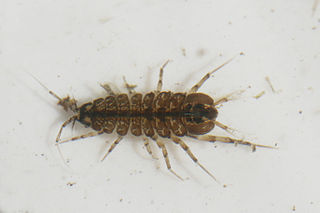
Asellus aquaticus is a freshwater crustacean resembling a woodlouse. It is known by various common names including pond slater, water louse, aquatic sowbug, water hoglouse and cress bug.
Speleoperipatus is a monospecific genus of velvet worm in the Peripatidae family, containing the single species Speleoperipatus spelaeus. This species is a pale greenish yellow, almost white, with 22 or 23 pairs of legs and no eyes. Specimens range from 27 mm to 34 mm in length. The minimum number of leg pairs found in this species (22) is also the minimum number found in the neotropical Peripatidae. This velvet worm is viviparous, with mothers supplying nourishment to their embryos through a placenta.
Carinurella paradoxa is a species of crustacean in family Niphargidae, and the only species in the genus Carinurella. It is found in phreatic waters of the Vipava and Soča rivers in Italy and Slovenia.
Monolistra is a genus of isopod crustaceans in the family Sphaeromatidae. Its members are restricted to countries of the former Yugoslavia, Italy and Switzerland. It contains the following subgenera and species, four of which are listed as vulnerable (VU) or endangered (EN) on the IUCN Red List:
Niphargus aberrans is a species of crustacean in the family Niphargidae. It is endemic to Slovenia.

Niphargus is by far the largest genus of its family, the Niphargidae, and the largest of all freshwater amphipod genera.
Niphargus hadzii is a species of crustacean in family Niphargidae. It is endemic to Slovenia, and is named after Slovene zoologist Jovan Hadži.
Niphargus hrabei is a species of crustacean in family Niphargidae. It is an originally Ponto-Caspian species that was found in the River Danube in Bavaria in the mid 1990s. It is now known to occur in Austria, Croatia, Hungary, Romania, Russia, Serbia and Montenegro, Slovakia, and Ukraine. It is listed as a vulnerable species on the IUCN Red List.
Niphargus sphagnicolus is a species of crustacean in family Niphargidae. It is endemic to Slovenia.
Niphargus spoeckeri is a species of crustacean in the family Niphargidae. It is endemic to Slovenia.
Niphargus stenopus is a species of freshwater amphipod crustacean which is endemic to Slovenia.
Niphargus timavi is a species of crustacean in family Niphargidae. It is found in Italy and Slovenia.
Niphargus valachicus is a species of crustacean in family Niphargidae. This species of crustacean is native to Bulgaria, Croatia, Hungary, Romania, Serbia and Montenegro, Slovakia, and Slovenia.
Typhlocypris cavicola is a species of ostracod crustacean in the family Candonidae. It is endemic to Slovenia, where it is only known from Krka Cave.
Typhlocypris trigonella is a species of ostracod crustacean in the family Candonidae. It is endemic to Slovenia, where it is known only from Postojna Cave.
Troglocaris anophthalmus is a species of freshwater shrimp in the family Atyidae. It lives in karstic caves in Bosnia and Herzegovina, Croatia, Italy and Slovenia. Although morphologically similar across its 500-kilometre (310 mi) range, molecular phylogenetics suggests that there are four or five cryptic lineages with more restricted ranges, although one such lineage does range unusually widely for a troglobite – over 300 kilometres (190 mi).

Typhlatya is a genus of shrimp in the family Atyidae. These are small, stygobitic shrimp found in the West Mediterranean region, Caribbean region, Ascension Island and the Galápagos, although the individual species often have very small ranges. Species in this genus are found in salt, brackish and fresh waters, mostly in anchialine habitats and none in the open sea.

Niphargidae is a family of amphipod crustaceans. Its distribution is in western Eurasia, and its members mainly live in subterranean freshwaters habitats. It contains the following genera:

Daipotamon minos is a cavernicolous freshwater crab species found in a single limestone cave near La Tai village in Libo county, Guizhou province at an altitude of about 600 m above sea level, where it inhabits slowly flowing or stagnant parts of a subterranean river. It is the only species of the genus Daipotamon.



